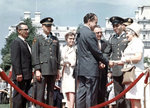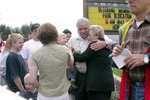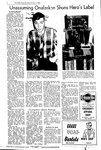


Few people are ever awarded the Congressional Medal of Honor, and none seek out the recognition. It is America’s most prestigious award for valor given to members of the military, noted Chip Duncan, director of the Veterans Memorial Museum in Chehalis.
Thomas J. “Jim” Kinsman was awarded the Medal of Honor by President Richard Nixon in 1969 after diving on a live grenade, saving the lives of other soldiers while in Vietnam.
“He would never want to be called a hero,” Duncan said, and he believed “any of the other guys around him would have done the same thing.”
Kinsman avoided any time in the spotlight due to the award, and rarely talked about his service in the Vietnam War or what he did to earn the medal. His children learned from their mother of their father’s selfless service.
The knowledge gave son Reggie Kinsman “incredible pride” and respect for his father, he said.
“It made me proud to know he did what he did,” he said.
Kinsman died at his home in May 2017, according to an obituary submitted by his family. He was 72.
He was born in Renton on March 4, 1945. He was a longtime resident of Toledo where he settled down after the war. He graduated from high school in Onalaska in 1963, where he played basketball and football.
He served in the Army from 1967 to 1970 and was awarded the Congressional Medal of Honor in 1969 by President Nixon for actions considered “above and beyond the call of duty” in the Vietnam War, according to his family.
Kinsman was the second Lewis County resident to ever receive the Medal of Honor. The first was Dexter Kerstetter, a Centralia resident who was awarded the medal for actions while serving in the Philippines in 1945.
According to Duncan, who has heard the story from members of Kinsman’s family, he and seven fellow soldiers were walking through a patch of elephant grass in Vietnam in 1968 when a grenade landed near them.
“He saw the grenade, he yelled ‘grenade,’ he realized the other guys were too close,” Duncan said. “He took his helmet off and he put it on his chest and he jumped on the grenade and got the grenade underneath his helmet.”
Kinsman was seriously injured, but likely saved the lives of the men around him, he said.
According to previous coverage in The Chronicle, he spent more than a year in hospitals recovering from his injuries.
“He made that split second decision to do that,” Duncan said.
Kinsman’s Medal of Honor has been displayed, with his permission, at the Veterans Memorial Museum since 1997.
“It was actually the first item that was ever … loaned to the museum,” Duncan said.
He noted that Kinsman didn’t loan the medal out of any desire to get attention or accolades, and he never came to the museum.
“Like everybody would always say, he’s really humble,” Reggie Kinsman said. “(He) never asked for anything … (He’s) about the most honest man I know.”
He spent the rest of his life avoiding the spotlight that often shines on Medal of Honor recipients. He declined to join the Congressional Medal of Honor Society because he would have been required to have speaking engagements, Duncan said.
“He was still just a down to earth guy,” he said. “I think his family and his kids were more the defining moments of his life than the medal.”
Kinsman was most recently a cattle farmer. He also worked as a logger after recovering and leaving the Army.
“He loved the freedom of having a farm,” Reggie Kinsman said.
In 2004, the Onalaska Community Association dedicated a park and a plaque at the corner of state Route 508 and Leonard Road as Veterans Memorial Thomas J. Kinsman Park.
According to Chronicle coverage of the event, Kinsman insisted the words “Veterans Memorial” come first.
A funeral is scheduled for 11 a.m. Monday at St. Francis Xavier Mission in Toledo.